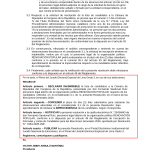The propaganda of Daniel Ortega and his wife Rosario Murillo also “paint” a country prosperous in energy generation, as they talk about how happy are those who without choice live under their government, even if it is by force. But in this case, contradiction arises every month when families must pay a high cost for the energy that reaches their homes.
The regime’s media, which is managed by the sons of Ortega and Murillo, frequently repeat that in recent years, Nicaragua has made a significant leap in energy generation. However, for many Nicaraguans, this supposed progress is not reflected in their pockets. “Here electricity is expensive,” says Don Marcos, a resident of the capital who, every time and when, must go to the offices of the energy distributor to make a payment agreement and thus avoid having his electricity supply cut off.
“In this country, either you eat or you are in the dark, they cut off your electricity and water, this Christian, socialist and supportive government does not forgive, you do not pay, there are no basic services,” says Don Marcos in an annoyed tone, who has just paid the bill. energy bill for September and must manage to solve October. “The problem is that there is no work either,” says the 49-year-old man who makes his living as a bricklayer.
Related news: Chinese state company will build solar power plant in Nicaragua
Don Marcos, like thousands of Nicaraguans, does not understand this: if what the regime says about the installed capacity to produce electricity is true, why do consumers like him pay such high rates in their homes, listing Nicaragua as one of the countries with the most expensive energy in the region.
Complaints in the neighborhoods
Doña Argentina Espinoza, a resident of the Colonia “10 de Junio” sector of Managua, is also another affected by the high costs of energy. She says the problem is so big that she has had to cut out daily activities that involve the consumption of electricity. “Here we have definitely suspended the use of the iron,” he comments for this article.
He points out that in his home, made up of three minors and three adults, “they live above the use of household appliances.” «We strive to use them as little as possible and we only use what is necessary; a refrigerator, a microwave, two televisions and seven light bulbs,” he explains. “Despite the heat, we try to avoid the fan as much as possible,” he adds. The reason is simple: if your consumption exceeds certain limits, the cost of energy “skyrockets.”
This reality reflects the dilemma faced by thousands of Nicaraguan families. This, although the regime happily reports that it has increased its capacity to generate energy in almost historic numbers. «It is not understood why if we produce more, we pay high rates. “We should have some benefit, right?” demands Don Marcos.
Related news: Ortega and his electrical business: The “clean energy” hoax
In the words of officials from the Nicaraguan Electricity Company (ENEL), “in 2006 we had about 600 megawatts (MW) of installed capacity, and now we have around 1,350 MW,” says its director Ernesto Martínez Tiffer. He also reported that a natural gas plant has been built in Puerto Sandino with a capacity of 320 MW, which would supposedly make it possible to reach more than 1,600 MW of installed capacity in the country.
If this good news translates into lowering the cost of energy that reaches the country’s homes, it would be a relief that thousands in neighborhoods and residential areas would appreciate, however, contrary to lowering the cost of rates, some families continue to receive almost unpayable receipts.
Changes in the energy matrix but…
One of the speeches of the Ortega-Murillo regime around this issue is that it has managed to change the country’s energy matrix in a very significant way. Its authorities point out that in 2006, more than 70% of the electricity in Nicaragua was generated using bunkers and diesel, which resulted in constant blackouts.

“But today, the country exceeds 50% of energy generated from renewable sources, such as hydroelectric and geothermal,” they point out. What is contradictory is that if before 2007 when Ortega came to power, people were already paying for expensive energy, now that they announce “that progress”, household rates, instead of going down or remaining stable, continue to increase in cost.
And in 2007, when Ortega assumed power, the cost per kilowatt hour (kWh) in the country was 0.14 dollars, which was equivalent to 2.81 córdobas at the exchange rate of the time. Today, in 2024, that cost has risen to 6.66 córdobas, equivalent to 0.18 dollars, a substantial increase considering that the dollar has increased from 18.8 to 36.1 córdobas in those 17 years.
“It is possible that there is progress in this matter, but there is little information available and there is no way to contrast what little is known or what the government says,” says an expert who requests to comment anonymously to avoid persecution by the regime.
The expert mentions that Costa Rica, having some of the highest costs of living in the region, offers the families who live there one of the lowest rates in Central America. He explains that that country has an installed capacity of 3,500 MW, almost three times what Nicaragua has. 94.9% of the electricity generated in Costa Rica comes from renewable sources, mainly hydroelectric, which for the expert, makes the authorities allow low and stable costs of home energy.
Costa Ricans pay 0.17 dollars per kWh. In the case of El Salvador and Guatemala, the rate is 0.14 dollars per kWh. El Salvador, with an installed capacity of 2,461 MW, has even managed to generate income of more than 40 million dollars thanks to the sale of energy to other countries.
Related news: Inhumane measure for retirees with electricity subsidies
The only nation that surpasses Nicaragua in high rates is Honduras. The cost is 0.20 dollars per kWh. Despite having a greater installed capacity than Nicaragua, of 2,937 MW, the lack of efficiency in resource management and dependence on non-renewable sources has kept rates high, according to the expert’s explanation.
The impact on homes
Doña María is another example of how high electricity costs have affected the lives of Nicaraguans. For years, his electricity bill was around 700 córdobas, but since 2022, it has increased to more than 2,000 córdobas. The abrupt change in costs was due to the fact that it was no longer a beneficiary of the electricity subsidies that the regime grants to consumers.


In Nicaragua, the government implemented a system of subsidies during the energy crisis of the 2000s. These subsidies have continued to this day, but they only benefit households that consume less than 150 kWh per month. In 2023, more than 939 thousand families and 66 thousand retirees received subsidies, according to official data.
However, with the reform of the law in 2018, the regime adjusted the subsidies, so that only those who consume between 0 and 50 kWh receive a 50% subsidy. Those who consume between 51 and 100 kWh receive 45%, while those who use between 101 and 150 kWh only benefit 25%. This means that any household that exceeds 150 kWh will see a significant increase in their bill.
Why does the regime sell energy so expensive? An economist who also asked to comment under protected identity explains that the high rates are due to several factors. Among them, he highlighted the marketing costs, the high cost of public lighting and the Value Added Tax (VAT), which can reach 15%. “All this means that any user who exceeds 150 kWh pays a high rate,” he warns.
New energy projects are not encouraging
Although Daniel Ortega’s regime boasts of progress in energy generation, the number of projects in that sector is still small. One of those that managed to materialize in the country is the natural gas plant in Puerto Sandino, promoted by the Norwegian company Statoil.
Most of the country’s electrical infrastructure dates back to previous decades, built even in the 50s, 70s and 90s. The boost to the production of wind energy stands out, whose projects were contracted from previous years, but were executed during this regime .
«There are many challenges in this matter, progress is pending in changing the energy matrix towards the production of renewable energy, there are steps, but few and very slow. There is no investment for this on the horizon, really,” says the specialist.
«The biggest problem is that as long as this progress is not reflected in alleviating the bill that families pay for electricity, it is not of much use, expensive energy increases the cost of living for an entire country and the cost of living in “Nicaragua has skyrocketed like it has not been seen in previous years,” says the economist.
















